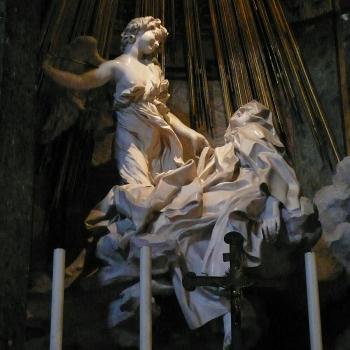I just read and loved this stiletto book, which I finally picked up after reading Amy Welborn’s glowing recommendation. I’ll just add a few notes to what she’s already said. The Girls of Slender Means is set in a rooming house for single women in the summer of 1945: Its main narrative opens on V-E Day and closes on V-J Day, although it’s framed by flash-forwards to a time when most of the girls–but perhaps not all–have gone on to better digs and brighter days.
Notable features for me: This is a novel of institutional life, like Infinite Jest, The Drinker, and Five for Sorrow, Ten for Joy. I live in a rooming house myself, and in general I’m on the hunt for more novels set in institutions rather than private homes. How do people live together when their ties of circumstance don’t include bonds of marriage or kinship?
It’s a conversion novel, as Welborn notes, but one thing I loved about the conversion story we see along the margins of the main characters’ lives is that it doesn’t result from an epiphany. Or at least, not only from that. We do see a moment of “savagery,” a moment of such shocking evil that a soul could turn on its point; but the soul in question had been prepared for that moment by the years leading up to it, by war experience and drawn-out Wildean dalliance with the Bride of Christ. And even the epiphany isn’t quite enough–there is one final twist of the knife, so to speak. This might seem like too much, but I loved it and thought it was psychologically realistic (we always need too much, more than one lesson) as well as spiritually accurate (the world doesn’t become something you can understand and cope with just because you’ve finally made your peace with your Creator).
You can easily spot the parallel between the lady author and a man character, which ordinarily I think I’d dislike (why not just write women?) but here it worked for me. Spark, like Nicholas Farringdon, has been captivated by the women of the May of Teck Club, and by the club itself, the institution. Farringdon is a figure of folly, a flighty creature; I would like to see this character type as a woman, we don’t get enough flighty women with religious depth, but I was still pretty charmed by him as a man. And I like that his sex marginalizes him at the May of Teck Club and gives him the ironic, fascinated position of the observer.
Agatha Christie apparently liked Muriel Spark a lot, and one similarity I noticed–which goes along with the novel’s arch, judicious tone–is that both novelists paint human nature in shades of folly and wickedness. Those old-fashioned words (a Christie character in The Pale Horse explicitly points out how nobody calls things “wicked” anymore) have found no adequate modern replacement. Folly, in particular, is a category we have a hard time naming. Christie generally portrays even her characters who do great and lasting harm–the instigator/victim in The Mirror Crack’d, for example–as extremes of a trajectory the best among us follow now and then. Folly can destroy a life; folly is an inevitable tint in every human action. Folly is ridiculous and deadly, and normal.
Which is basically how this novel views the war, too; it’s got that bravado of so many Blitz stories, the national myth of nonchalance. I always enjoy that bracing atmosphere of tea and no excuses. I doubt that I would react so gallantly to bombing raids.
Welborn mentions this, but the structure of this novel is just so tight. The spring coils and then the trap snaps shut, and then we’re done.











